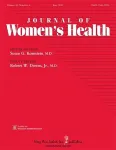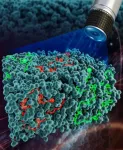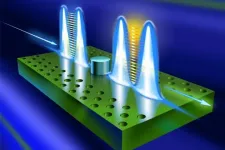(Press-News.org) RICHLAND, Wash.--Researchers have increased the lifetime of a promising electric vehicle battery to a record level, an important step toward the goal of lighter, less expensive and long-lasting batteries for future electric vehicles. The work is reported June 28 in the journal Nature Energy.
Such batteries--the goal of research groups the world over--are seen as an important part of the solution to reduce the effects of climate change, and scientists are exploring a dizzying array of options.
One solution on the horizon is a lithium-metal battery for electric vehicles. These batteries hold almost twice the energy of their widely used lithium-ion counterparts, and they're lighter. That combination offers the enticing prospect of an electric vehicle that would be lighter and go much farther on a single charge. But lithium-metal batteries in the laboratory have been plagued by premature death, lasting only a fraction of the time of today's lithium-ion batteries.
Now, a team of scientists at the U.S. Department of Energy's Pacific Northwest National Laboratory has created a lithium-metal battery that lasts for 600 cycles, far longer than other reported results. That means it can be fully charged and discharged 600 times before it dies.
It's a big step forward for a promising technology, but lithium-metal technology is not yet ready for prime time. While the lithium-ion batteries used in electric vehicles today hold less energy, they last longer, typically at least 1,000 cycles. But vehicles won't go as far on one charge as they would with an effective lithium-metal battery.
The new research was done through DOE's Innovation Center for Battery500 Consortium, a multi-institution effort led by PNNL to develop electric vehicle batteries that are lighter, more energy intensive and less expensive than those currently used. PNNL leads the consortium and is responsible for integrating the latest advances from partner institutions into devices known as high-energy pouch cells and demonstrating improved performance under realistic conditions.
Lithium metal: Thin strips of lithium translate to longer lifetime
The PNNL team found a way to increase the battery's lifetime by taking a surprising approach. Instead of using anodes with more lithium, the team used incredibly thin strips of lithium, just 20 microns wide, far thinner than the width of a human hair.
"Many people have thought that thicker lithium would enable the battery to cycle longer," said Jie Xiao, who along with Jun Liu, the director of the Battery500 Consortium, is a corresponding author of the paper. "But that is not always true. There is an optimized thickness for each lithium-metal battery depending on its cell energy and design."
The lithium-metal battery created by the Battery500 team has an energy density of 350 watt-hours per kilogram (Wh/kg)--very high but not unprecedented. The value of the new findings has more to do with the battery's lifetime. After 600 cycles, the battery retained 76 percent of its initial capacity.
Just four years ago, an experimental lithium-metal battery could operate for 50 cycles. That has increased rapidly; two years ago the PNNL team achieved 200 cycles--and now 600. Moreover, the PNNL battery is a pouch cell, which more closely mirrors real-world conditions than does a coin cell, a less realistic type of device used in many battery research projects.
Lithium metal: Why thickness matters
The team's decision to try thinner lithium strips was based on its detailed understanding of the molecular dynamics of the anode as explained in the Nature Energy paper.
The scientists found that thicker strips contribute directly to battery failure. That's due to complex reactions around a film on the anode known as the solid electrolyte interphase, or SEI. The SEI is the byproduct of side reactions between lithium and the electrolyte. It acts as an important gatekeeper that allows certain molecules to go from the anode to the electrolyte and back again while keeping other molecules at bay.
It's an important job. An SEI working effectively allows certain lithium ions to pass through but limits unwanted chemical reactions that reduce battery performance and accelerate cell failure. A primary goal for researchers has been to reduce unwanted side reactions between the electrolyte and the lithium metal--to encourage vital chemical reactions while restraining unwanted ones.
The team found that thinner lithium strips are adept at creating what one might call good SEI, while the thicker strips have a higher chance of contributing to what one might call harmful SEI. In their paper, the researchers use the terms "wet SEI" and "dry SEI." The wet version retains contact between the liquid electrolyte and the anode, making important electrochemical reactions possible.
But in the dry version, the liquid electrolyte doesn't reach all of the lithium. Simply, because the lithium strips are thicker, the electrolyte needs to flow into deeper pockets of the lithium, and as it does so, it leaves other portions of the lithium dry. This stops important reactions from occurring, effectively smothering necessary electrochemical reactions, and contributes directly to the early death of the battery.
It's an important issue, especially in realistic batteries like pouch cells, where the amount of electrolyte available is 20 to 30 times less than that used in experimental coin cells.
Consider how a frying pan gradually builds up a layer of grease if not cleaned thoroughly after each time it is used. Over time, the layer builds up and acts as a barrier, reducing the flow of energy and making the surface less effective. In the same way, an unwanted, dry SEI layer prevents the effective transfer of energy needed inside a battery.
Progress thanks to Battery500
The progress on lithium-metal batteries has been substantial, thanks to the Battery500 Consortium. The goal is to increase the amount of energy packed into a long-duration, safe, affordable battery. More energy per pound of material translates to a lighter vehicle that can go farther on one charge. Today's electric vehicle batteries are in the neighborhood of 200-250 Wh/kg; Battery500 is aiming for a cell level of 500 Wh/kg.
"The Battery500 Consortium has made great progress in increasing the energy density and extending the cycle life," said Distinguished Professor M. Stanley Whittingham of Binghamton University, the 2019 Nobel Prize laureate in chemistry and a coauthor of the paper. "But much more needs to be done. In particular, there are safety issues with lithium-metal batteries that must be addressed. That's something that the Battery500 team is working hard to resolve."
INFORMATION:
The work was funded by DOE's Office of Energy Efficiency and Renewable Energy's Vehicle Technologies Office. Much of the microscopy to evaluate the battery was done at EMSL, the Environmental Molecular Sciences Laboratory, a DOE Office of Science user facility located at PNNL.
In addition to Liu, Xiao and Whittingham, authors include PNNL scientists Chaojiang Niu, Dianying Liu, Joshua Lochala, Cassidy Anderson, Xia Cao, Mark Gross, Wu Xu and Ji-Guang (Jason) Zhang. Xiao and Liu also have appointments at the University of Washington.
(San Antonio, June 29, 2021) - UTSA criminology and criminal justice professors Michael R. Smith and Rob Tillyer working in collaboration with University of Cincinnati Professor Robin Engel examined racial and ethnic disparities in the use of force by the Fairfax County Police Department (FCPD). One of the nation's largest county police departments, the FCPD serves Fairfax County, Va., a major metropolitan county near Washington, D.C.
The team presented the results of its 18-month study today to the Public Safety Committee of the Fairfax County Board of Supervisors. ...
The historic 2020 hurricane season, with its record-breaking 30 tropical storms and hurricanes, left in its wake hundreds of deaths in the United States, tens of billions of dollars in damages, and one important question: Is this what the future will look like?
While most climate scientists agree that hurricane severity, at least in terms of rainfall, will likely increase as the planet warms, there remains uncertainty about the future frequency of hurricanes. Today's climate models offer a range of possible futures, some predicting an increase in North Atlantic hurricane frequency, others a decrease. These conflicting results beg the question: are these ...
HOUSTON - (June 29, 2021) - When you think about trade and market relationships, you might think about brokers yelling at each other on the floor of a stock exchange on Wall Street. But it seems one of the basic functions of a free market is quietly practiced by fungi.
New research from a Rice University economist suggests certain networks of fungi embrace an important economic theory as they engage in trading nutrients for carbon with their host plants. This finding could aid the understanding of carbon storage in soils, an important tool in mitigating climate change.
A research paper entitled "Walrasian equilibrium behavior in nature" is available online and will appear in an upcoming edition of Proceedings of the National Academy of Sciences. Ted Loch-Temzelides, ...
Among low-income, uninsured, or publicly insured women ages 25-64 years who were not up to date on cervical cancer screening, 72% perceived financial barriers to screening. The most commonly reported barriers were screening appointment costs (71%) and follow-up/future treatment costs (44%), according to a study published in the peer-reviewed Journal of Women’s Health. Click here to read the article now.
Screening is effective at reducing the incidence of and mortality associated with cervical cancer. However, disparities exist in cervical cancer incidence and mortality and in cervical cancer screening based ...
Langerhans cell histiocytosis (LCH) is a rare cancer involving dendritic cells, a type of white blood cell that usually helps defend against infections. The current standard of care for LCH, chemotherapy, cures fewer than half of patients.
"Our research team focuses on identifying the causes of LCH so that we can develop better therapies for patients," said Dr. Rikhia Chakraborty, assistant professor of pediatrics - hematology and oncology at Baylor College of Medicine.
Most cells in LCH lesions are not abnormal dendritic cells but other invading immune cells, such as T cells, that are recruited to sites of disease. The contribution of T cells and other immune cells to LCH disease is not known. Chakraborty and her team at the Texas Children's Cancer Center Histiocytosis Program characterized ...
Mate choice is important for females, who often invest much more energy in offspring than males. However, being too selective is a bad idea, as they might end up not mating at all. Biologists have wondered for a long time how females optimize their chances. Scientists at the University of Groningen have performed experiments with fruit flies that reveal the explanation: mating induces a behavioural change in female flies that makes them more choosy than when they are virgins. The results were published on 21 June in Nature Ecology and Evolution.
The fourteenth-century French philosopher Jean Buridan described a donkey who starved to death because he couldn't choose between two bales of hay. Evolutionary biologists have their own version of this decision-making ...
University of Colorado Boulder researchers have discovered that minuscule, self-propelled particles called "nanoswimmers" can escape from mazes as much as 20 times faster than other, passive particles, paving the way for their use in everything from industrial clean-ups to medication delivery.
The findings, published this week in the Proceedings of the National Academy of Sciences, describe how these tiny synthetic nanorobots are incredibly effective at escaping cavities within maze-like environments. These nanoswimmers could one day be used to remediate contaminated ...
Research from the McKelvey School of Engineering at Washington University in St. Louis has found a missing piece in the puzzle of optical quantum computing.
Jung-Tsung Shen, associate professor in the Preston M. Green Department of Electrical & Systems Engineering, has developed a deterministic, high-fidelity two-bit quantum logic gate that takes advantage of a new form of light. This new logic gate is orders of magnitude more efficient than the current technology.
"In the ideal case, the fidelity can be as high as 97%," Shen said.
His research was published in May 2021 in the journal Physical Review A.
The potential of quantum computers is bound to the unusual properties of superposition -- the ability of a quantum system to contain many distinct properties, or states, ...
Irvine, Calif., June 29, 2021 - Fireworks are synonymous in the United States with the celebration of Independence Day and other special events, but the colorful displays have caused a growing risk to public safety in recent years, according to a study by environmental health researchers at the University of California, Irvine.
Relying on real-time air quality measurements crowdsourced from a network of more than 750 automated sensors distributed throughout California, scientists from UCI's Program in Public Health found that short-term, extremely high-particulate-matter air pollution from the widespread ...
This lobster tale begins a few years ago when the proprietor of a northeastern seafood restaurant publicly asserted that exposing lobsters to a little cannabis prior to cooking produced notable changes in their behavior and a less dramatic scene in the kitchen for all concerned, which was the Maine thing.
In a paper published online June 29, 2021 in the journal Pharmacology Biochemistry and Behavior, a team led by researchers at University of California San Diego School of Medicine, report on efforts to answer that burning, boiling and baked question. They obtained live lobsters (Homarus americanus) from a supermarket and exposed the crustaceans to up to 60 minutes of vaporized Δ9-tetrahydrocannabinol (THC) -- the principle psychoactive component of cannabis -- then ...




